Last Updated on December 30, 2024 by Alex Birkett
Website analytics as an industry has come a long way.
Once upon a time, it wasn’t so easy to collect data (nor analyze it) from your web pages.
Now, we have an absolute gluttony of web analytics software available to us, ranging from the free and open source to the enterprise and highly advanced.
I’ve worked in analytics for years. By trade, I’m a conversion rate optimization specialist as well as a content agency founder. In both of these roles, my foundational skill set is in analysis. Thus, I’ve spent more time in website analytics and digital analytics tools than any other software.
And I’ve got opinions on the best ones. I’ll outline them for you here.
First, however, let me describe what website analytics are and how they differ from other forms of analytics, like marketing analytics, product analytics, or other forms of data.
The 15 Best Website Analytics Tools in 2025
- Google Analytics (GA4)
- Snowplow Analytics
- Heap Analytics
- Adobe Analytics
- HubSpot
- Matomo
- Yandex Metrica
- Amplitude
- Mixpanel
- Fullstory
- Woopra
- HotJar
- LuckyOrange
- Mouseflow
- Medallia
Here’s a comparison table summarizing the key features, pros, and cons of the web analytics tools mentioned in the list:
| Tool | Key Features | Pros | Cons | Price | G2 Score |
|---|---|---|---|---|---|
| Google Analytics (GA4) | Free-tier tracking, enhanced e-commerce, real-time analytics, cohort analysis | Ubiquitous, free for basic use, powerful integrations, customizable tracking | Enterprise version is expensive, data sampling in free version, limited raw data access | Free, then enterprise | 4.2 |
| Snowplow Analytics | Open source, raw event data, customizable, advanced analytics | Data ownership, highly customizable, ideal for advanced analysts | Requires technical setup, not plug-and-play, no transparent pricing | Request demo | 4.6 |
| Heap Analytics | Automatic event tracking, historical data, user behavior analysis | Easy setup, powerful integrations, complete historical data | Can overwhelm with data, requires careful analysis | Free, then custom pricing | 4.4 |
| Adobe Analytics | Advanced segmentation, cohort analysis, integration with Adobe suite | Enterprise-grade power, great for large-scale businesses | Expensive, steep learning curve | Contact sales | 4.0 |
| HubSpot | CRM integration, marketing attribution, reporting tools | All-in-one marketing solution, good for SMBs, integrates with other HubSpot tools | Limited customizability, data ownership concerns, expensive upgrades | Free basic, $50/month+ | 4.4 |
| Matomo | Privacy-focused, customizable, on-premise/cloud options | Open source, GDPR-compliant, great Google Analytics alternative | Requires technical expertise for advanced setup, less intuitive UI | Starts at $29/month | 4.2 |
| Yandex Metrica | Completely free, session replays, heatmaps | Free, solid features for user behavior analysis | Limited global adoption, primarily Russia-focused | Free | 4.3 |
| Amplitude | Cohort analysis, user segmentation, A/B testing integration | Excellent for product analytics, advanced automation, strong growth | Expensive for larger use cases, some limitations in channel attribution | Free, then custom pricing | 4.5 |
| Mixpanel | User identification, funnel analysis, retention metrics | Solid for product analytics, detailed user behavior tracking | Limited flexibility in custom reporting, can feel rigid for non-standard use cases | Free, $25/month+ | 4.4 |
| Fullstory | Session replays, heatmaps, form analytics | Combines qualitative and quantitative insights, excellent for conversion research | Expensive, unintuitive UI | Contact sales | 4.5 |
| Woopra | Customer journey analytics, automation tools, retention tracking | Great for tracking user journeys, automation capabilities | Expensive paid plans, less adoption compared to competitors | Free, $349/month+ | 4.4 |
| HotJar | Heatmaps, session replays, surveys, feedback tools | Affordable, intuitive UI, all-in-one CRO tool | Limited advanced analytics, less customizable compared to enterprise tools | Free, $39/month+ | 4.3 |
| LuckyOrange | Heatmaps, session replays, live chat | Affordable pricing, live chat feature, flexible | Less recognized, fewer advanced analytics features | $10/month+ | 4.3 |
| Mouseflow | Session replays, heatmaps, funnel analysis | Easy to use, qualitative insights, affordable | Limited advanced segmentation, slower than competitors | Free, $24/month+ | 4.7 |
| Medallia | Digital experience scoring, session replays, journey mapping | Enterprise-grade, deep insights into user personas, strong A/B testing integration | Expensive, unclear pricing, steep learning curve | Request demo | 4.4 |
Recommendations Based on Use Case:
- Best for beginners: Google Analytics, Yandex Metrica
- Best for privacy-focused businesses: Matomo
- Best for product analytics: Amplitude, Mixpanel
- Best for qualitative insights: HotJar, LuckyOrange, Mouseflow
- Best for enterprise users: Adobe Analytics, Decibel Insight
- Best all-in-one marketing platform: HubSpot
1. Google Analytics
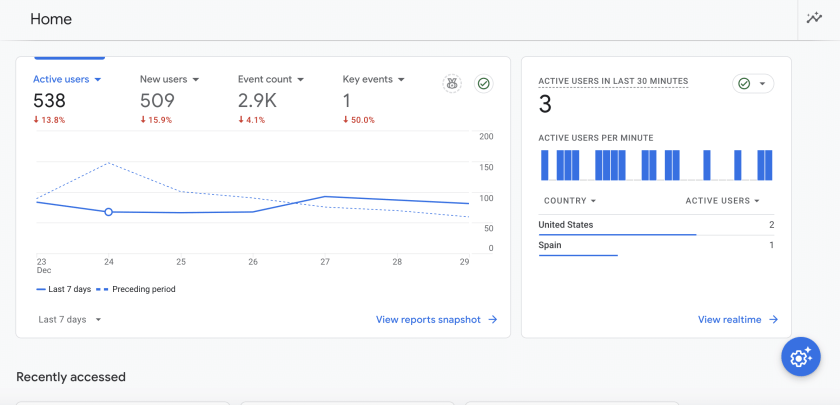
Ahhh Google Analytics. GA. The tried-and-true, nearly ubiquitous web analytics tool.
If you’re a marketer, or really anyone doing stuff with websites or tech, you’ve almost certainly seen a Google Analytics report. Actually, if you’re a marketer and don’t know the basics of Google Analytics, I’d run to your nearest course supplier today (free: Google’s Academy. Paid: CXL Institute).
What is Google Analytics? Well, out of the box, it’s going to collect clickstream data based on cookies (review this). You’ll get channel reports: how many people came to your site from PPC, SEO (search engine referrals from Google/Bing/Organic), social media, Direct, Referral, Email, etc.?
You’ll get landing page and behavioral reports: how many people entered the site through a given page? How many page views, event triggers, site searches were there?
You’ll get engagement metrics. What’s the bounce rate, exit rate, entrance rate of a given page? How many pages per session do you have on average? What’s the average time on site?
And you’ll get user data. What browser type and device type is a visitor using? What’s their age and demographics? Are they a new or return visitor? How *many* sessions have they had?
And that’s just the basics; wait until you learn about enhanced e-commerce, real-time analytics, cohort analysis and all the cool stuff in GA4, and the literally endless possibilities introduced by Google Tag Manager and measurement protocol.
If you can think it, with Google Analytics, you can probably track it.
Cool thing? Starts out as a free tool.
Price: Starts free, then Google Analytics 360 is incredibly expensive
G2 score: 4.2
2. Snowplow Analytics
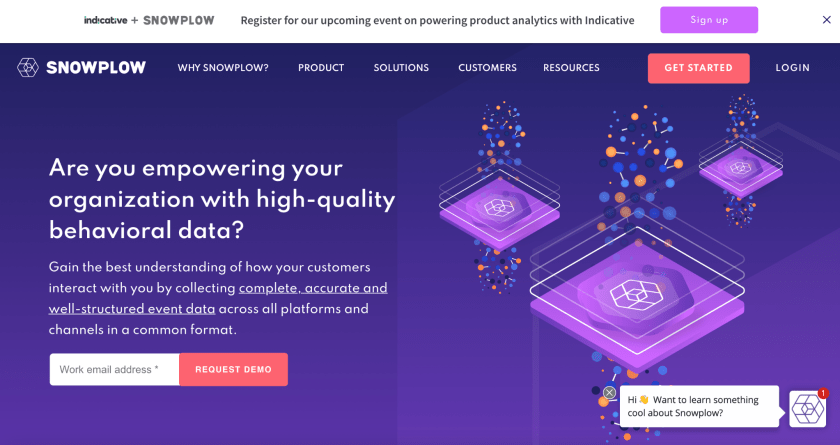
You may or may not have heard of Snowplow.
If you’re a hardcore analyst, you’ve probably heard of it. If you’re new to the game, you probably haven’t.
Snowplow analytics is indicative of a larger trend: people want to own their data.
Google Analytics is awesome, but there’s a lot of fuckery with our things are surfaced up and reported, and it’s often difficult to get raw and upsampled data in the format you’d like it (that is, unless you’re on the enterprise version).
Snowplow is an open source data analytics solution that is based on event tracking (arguably a superior way to map out your measurement strategy – source). THey’ve quickly risen in popularity the last few years, and I’d expect that only to grow in the future.
Here’s how it would work if you were a Snowplow analytics user:
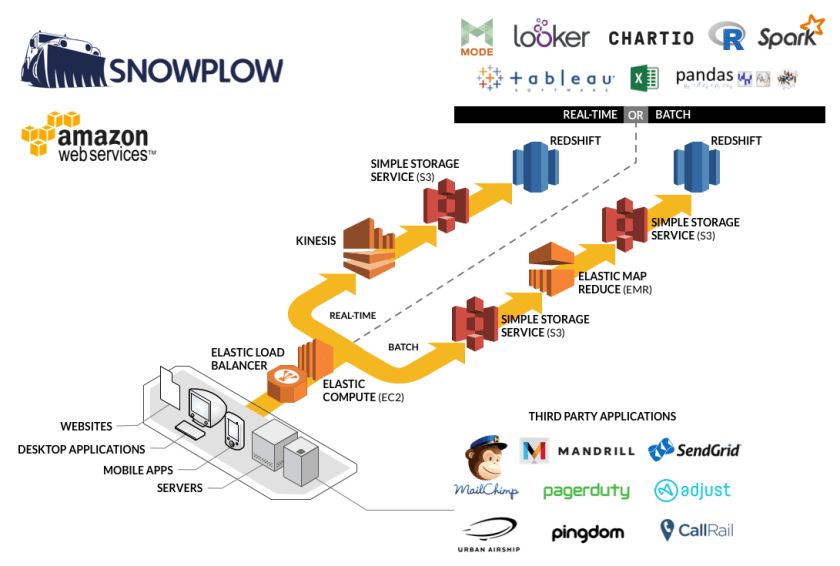
Sure, a bit more complicated than plug-and-play Google Analytics. But if you’re serious about measurement and optimization (plus data ownership), then it’s likely worth it.
Price: Unavailable (request demo)
G2 score: 4.6
3. Heap Analytics
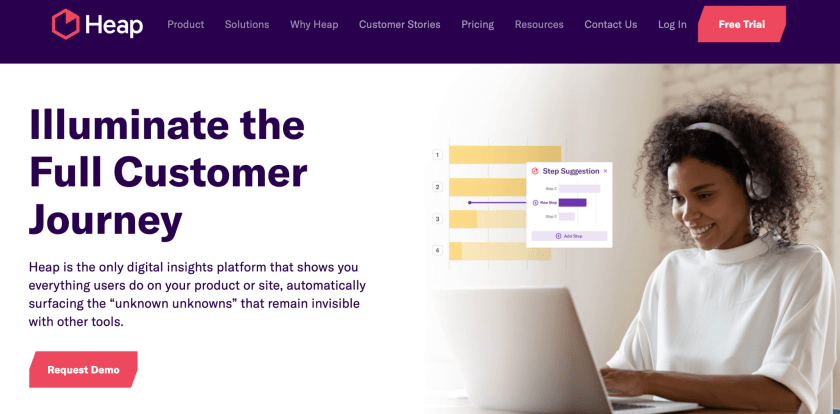
Heap Analytics, in many ways, is on the opposite side of the spectrum of web analytics tools as Snowplow.
With Snowplow, you’ll map out your events, set everything up proactively, and control the flow of your data from start to finish.
Heap Analytics, on the other hand, automatically tracks everything it can about your users. This makes it one of the easiest tools to set up and use out of the box, but it also means you could have a gluttony of information.
It all depends on what type of a data-driven culture you have. For example, engineering-heavy companies will have no problem unlocking the power of a platform like Snowplow (or Matomo), whereas development resources could be a constraint for many companies. Heap lets you surpass some of this resource bottleneck, though then the burden is on the analysis of the data you’re collecting (there’s no free lunch, they say).
In any case, Heap has made waves in the digital analytics space, and for good reason. It’s a powerful product analytics and website analytics platform that performs a wide variety of functionalities, including automated ETL, automatically merging anonymous and identified behavior, and access to complete historical data.
It also integrates well with A/B testing tools like Optimizely and VWO.
Price: Starts free (then customized pricing based on events)
G2 score: 4.4
4. Adobe Analytics
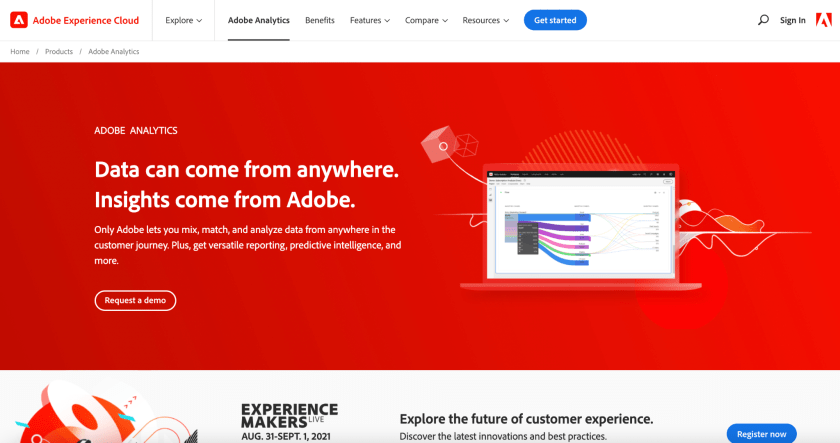
Adobe Analytics is the name I think of when I think of enterprise website analytics.
Of course, you’ve got the whole suite of Adobe’s marketing productings, including Adobe Target, and now, Marketo. So if you’re already using some or all of these tools, then Adobe Analytics is the obvious choice.
In many ways, Adobe Analytics represents the high end of the analytics market. It’s incredibly powerful and highly customizable.
I’ll be honest here, though, it’s probably the tool on this list I’ve got the least hands-on experience with. It’s simply not a tool many of the organizations I’ve worked with have used.
That said, my friends in the analytics industry tend to love this one for the aforementioned reasons: power, complexity, scale.
Price: talk to sales
G2 score: 4
5. HubSpot

HubSpot is a full suite marketing and sales platform that makes pretty much every type of MarTech tool.
While famous for the CRM, email marketing, and marketing automation offerings, they have a pretty decent set of website analytics tools as well.
Three things to me stand out about the product:
First, since they have all the other marketing tools (landing pages, email, live chat, ads, CRM), you’re really getting a great single source of truth for your marketing and customer data. This eliminates a lot of the data engineering work typically required to blend and enrich the data you’re collecting, so you can immediately make use of it.
Second, they’re quite specifically good at marketing analytics and attribution. This is something that other tools, even Google Analytics, are frustratingly bad at. Being able to tell when, how, and from where someone came to your website is such a core business question, and HubSpot helps you answer that.
Finally, the basic reporting tools start out free, and the advanced stuff comes with any of the pricing tiers that include other tools like email and marketing automation.
There are many downsides, though. Their reporting and analytics are basically the opposite of customizable. And it would be hard to argue that you’re the owner of your data when using HubSpot. It’s nearly impossible to use the analytics API and construct things in a customizable format. So for the advanced analysts, you’ll almost certainly end up feeling that the tool is lacking in power and customizability.
But I think this one is good for marketers, and you can still set up something like Snowplow or Google Analytics for more advanced uses.
Price: starts free (then $50/month for Starter tier)
G2 score: 4.4
6. Matomo
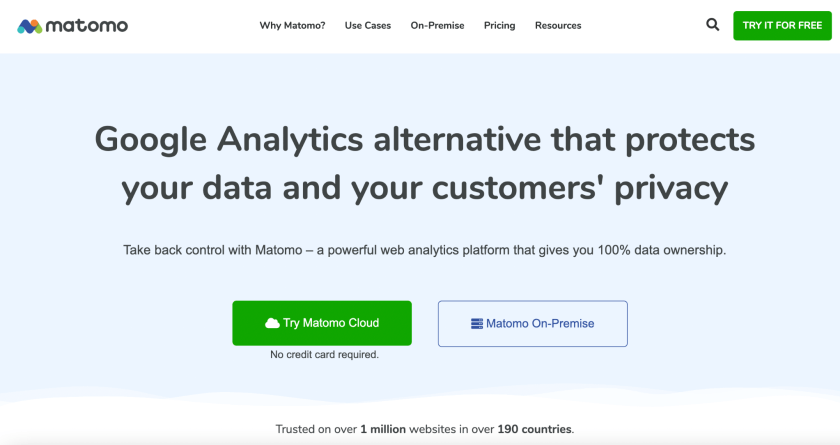
Matomo, formerly known as Piwik, is like the DuckDuckGo of the analytics world.
Google, famous and well-liked for many things, is not necessarily a beacon of privacy and security. Matomo’s positioning here is that of the Google Analytics alternative that actually cares about user privacy.
Open source and with cloud and on-premise options, you can definitely call this platform customizable. And for IT and security teams looking for something with a little more assurance, this is a great Google Analytics alternative.
Price: depends on usage (starts near $29/mo)
G2 score: 4.2
7. Yandex Metrica
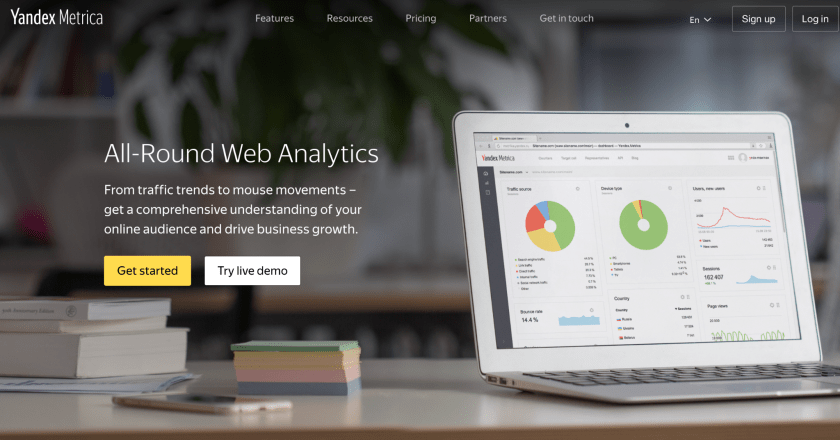
Yandex Metrica is the Russian Google Analytics. It’s also the third most widely used web analytics service on the web.
Also, it’s completely free.
Price: completely free
G2 score: 4.3
8. Amplitude
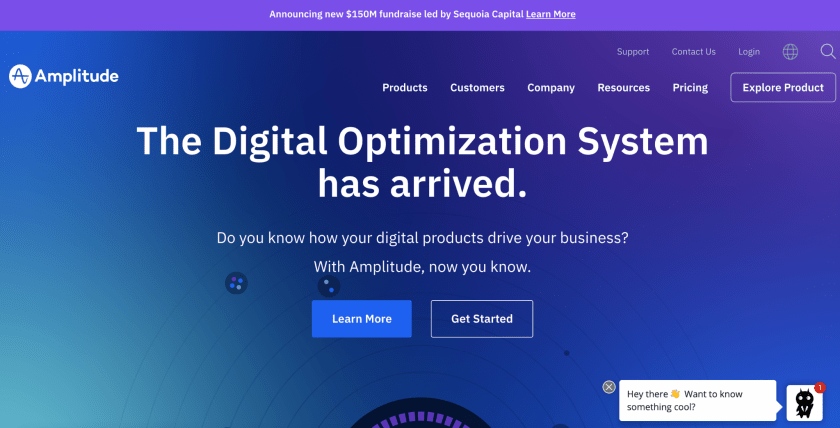
Amplitude might be the most popular product analytics tool in the game right now.
They came on my radar around 2015, back when they positioned themselves as “mobile app analytics” or “app analytics.”
The feature that I remember them for was an automated way to analyze and identify the “aha moment” in a product (like Facebook’s famous 7 friends in 7 days heuristic). This isn’t an altogether hard thing to do, analysis-wise – it’s a multivariable regression in most cases (and in many, many cases, it’s actually better to find these things qualitatively).
Now, they’ve expanded capabilities around automating the analysis portion of a PM or marketer or analyst’s job. Things like funnels, cohort analyses, identifying personas and segments, identifying friction points, and more.
That’s just on the analytics side of things.
They just raised a shitload of money from Sequoia and have built out solutions for machine learning driven personalization and have recently launched an experimentation platform as well.
I’m bullish on Amplitude. I think the team is incredibly smart and the product has gotten remarkably better over time. If I were to pick a product analytics tool, this would be the one. I’d still probably combine that with a marketing analytics solution, especially to fill the gaps on channel attribution and conversion funnels.
Price: starts free (then contact sales)
G2 score: 4.5
9. Mixpanel
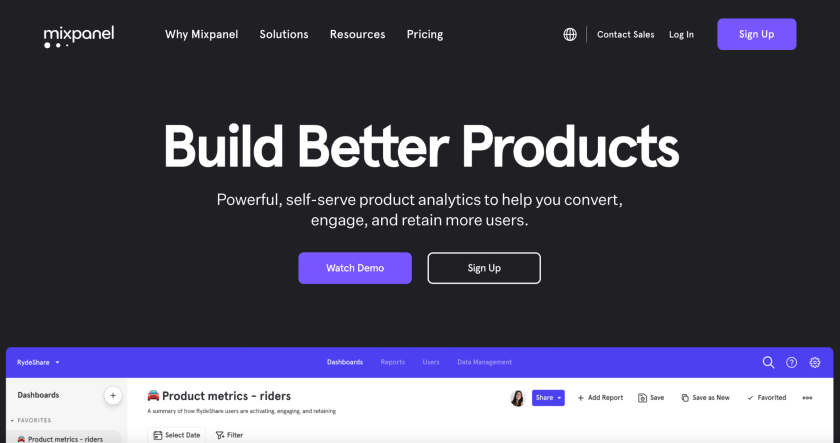
Mixpanel is the first company I can remember that marketed themselves as a product analytics solution.
They’ve been around since 2009, which seems like an eternity for the modern analytics industry. They came up in the same crop as tools like KissMetrics, which hoped to fill in the gaps that Google Analytics missed.
In terms of functionality, Mixpanel is excellent, especially when it comes to user stitching and identification. This was even a core differentiator before they called themselves a product analytics tool, and it’s something that led many users to choose them over Google Analytics in the heyday.
For transparency, I haven’t used Mixpanel in the past few years. But from talking to friends who use the tool, they say it’s just about on-part with Amplitude and it’s improving greatly with time. The big frustrations seem to be around the lack of custom formulas and, generally, flexibility in reporting and analysis.
This, however, is something I’ve experienced with almost all ‘product analytics’ tools. They’re great at out-of-the-box reporting, especially with things like cohort analysis and funnels. But when it comes to fringe business questions, you really have to work to pull together hacky solutions.
Anyway, if you want to measure the full funnel from conversion to product engagement to retention, Mixpanel is a solid solution.
Price: starts free, then $25/month for starter tier
G2 score: 4.4
10. Fullstory
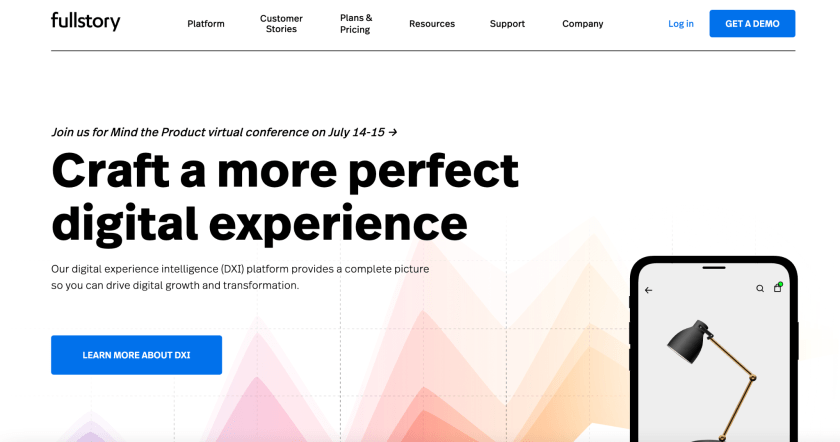
Alright, we’re now somewhat stepping away from the world of purely quantitative website analytics, and now we’ve got a tool that does a mixture of qualitative and quantitative measurement.
Fullstory is a popular web analytics solution used by tons of SaaS companies (as well as other industries, but particularly SaaS). It’s got several powerful features to track engagement across your website:
- Session replay videos
- Heatmaps (clickmaps, scroll maps, hover maps)
- Custom funnels
- Form analytics
There is some irony in the fact that, at least in my humble opinion, Fullstory’s UI is quite unintuitive. It took me a full week or two to figure out how to find the heatmap reports for instance.
But they make up for it in their ability to tie together pretty much the whole customer journey of individual users, which is incredibly useful when it comes to doing conversion research and identifying user experience bottlenecks. This marketing platform helps you view customer behavior on individual visitors, such as where they’re scrolling, where they’re clicking, and where they’re bouncing.
This is a great compliment to a tool like Google Analytics, which purely reports on quantitative data.
Price: talk to sales
G2 score: 4.5
11. Woopra
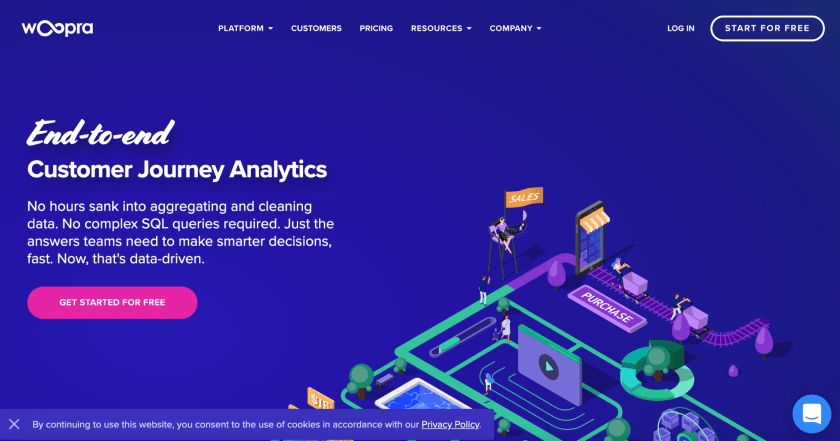
Woopra is another customer journey analytics tool that seeks to give you a more holistic view of your visitors, users, and customers.
Their three key features are:
- Journeys – tracking users across multiple touchpoints on your website and in your product
- Trends – mapping the growth of key metrics
- Retention – measuring and optimizing user retention
A cool differentiator is that Woopra not only gives you the ability to track, analyze, and report on data, but they also help you *do* something about it. They have a set of automation tools that allow you to trigger different types of experiences based on the data you’re collecting.
I like Woopra a lot. They’re another tool that I feel has just gotten progressively better, and much different from other tools in the space, over time.
Price: starts free (then $349/mo)
G2 score: 4.4
12. HotJar
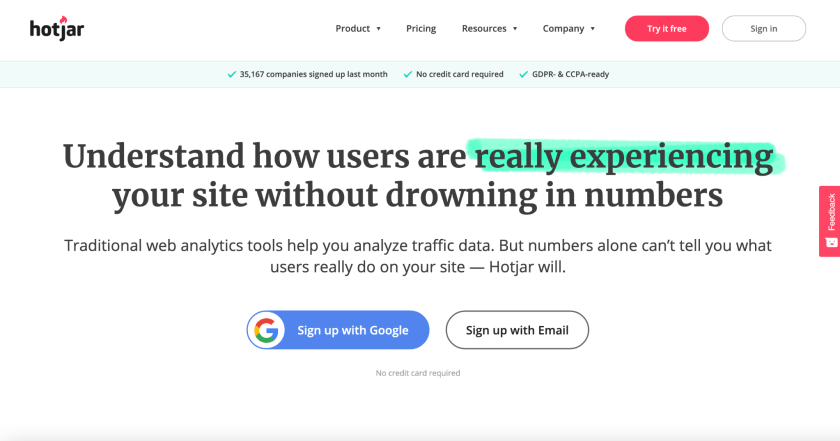
HotJar is the first tool on this list that I would consider purely qualitative.
It’s also one of my favorite conversion rate optimization tools out there.
Here are just some of their features:
- Session replay videos
- Heatmaps (scroll maps, click maps, hover maps)
- On-site polls
- Customer surveys
- Funnels
- Form analytics
- Visual website feedback forms
There are three things I really like about HotJar:
- It’s affordable. Probably the best value for what you get in the market.
- It’s super easy to use. I could grok it within a day.
- It’s all-in-one. I’d rather not weight my site down with a ton of javascript snippets if I could instead just use one tool.
If I were forced to choose one qualitative tool, it would probably be HotJar. I’m not alone; this tool is incredibly popular. It’s rare to meet a website optimizer who hasn’t used this tool extensively.
Many people will recommend specific products for each of these features (like CrazyEgg for heatmaps and Qualaroo for polls). This is fine, and it’s important for many companies with advanced use cases. But for many companies, HotJar will do the job just fine
Price: starts free (then $39/month)
G2 score: 4.3
13. LuckyOrange
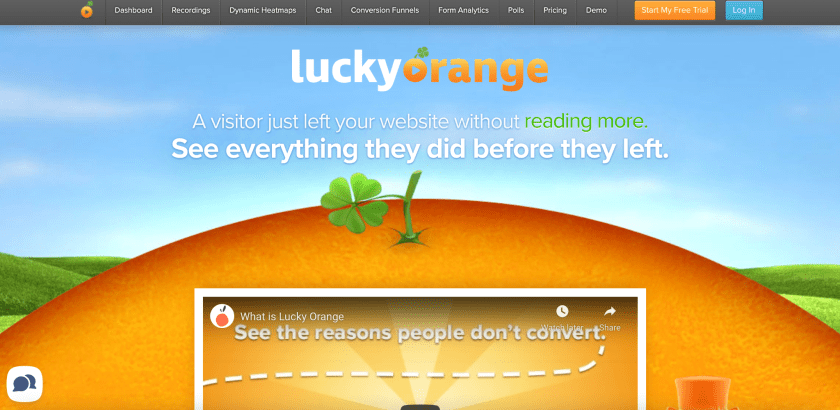
LuckyOrange is a qualitative user experience analytics tool that offers an incredible array of features.
Not only do they have heatmaps, session replay videos, form analytics, funnels, and polls, but they also have a live chat option. This not only helps you collect insights and feedback from visitors, but may actually help convert more visitors as well.
Apart from their stacked feature set, they’ve also got some of the best pricing options out there, the first tier starting at just $10/month. I’ve found the tools incredibly easy to use as well as flexible.
While HotJar may have greater brand awareness, LuckyOrange is a formidable alternative and in some ways is superior (though I still love the HotJar poll feature and CrazyEgg for heatmaps).
Price: starts at $10/month
G2 score: 4.3
14. Mouseflow
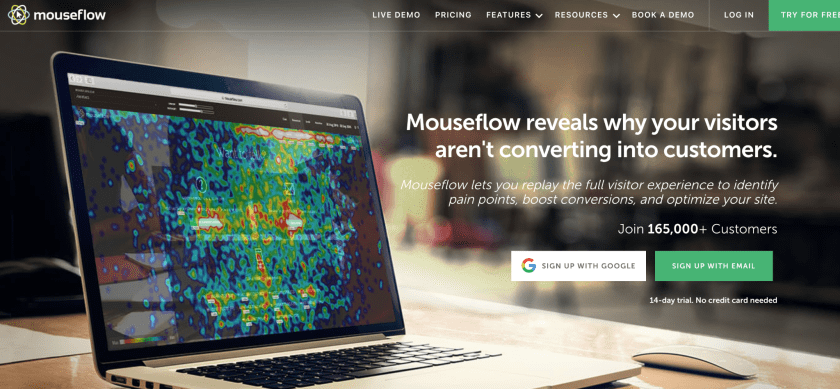
Mouseflow is another qualitative insights product with session replay videos, heatmaps, conversion funnel analytics, form analytics, and website feedback collection.
I haven’t used Mouseflow in a few years, but in the past I’ve always found it useful and easy to get started. Additionally, they’ve got a freemium option, so you can easily kick the tires before committing to anything.
Price: starts free, next tier begins at $24/month
G2 score: 4.7
15. Medallia
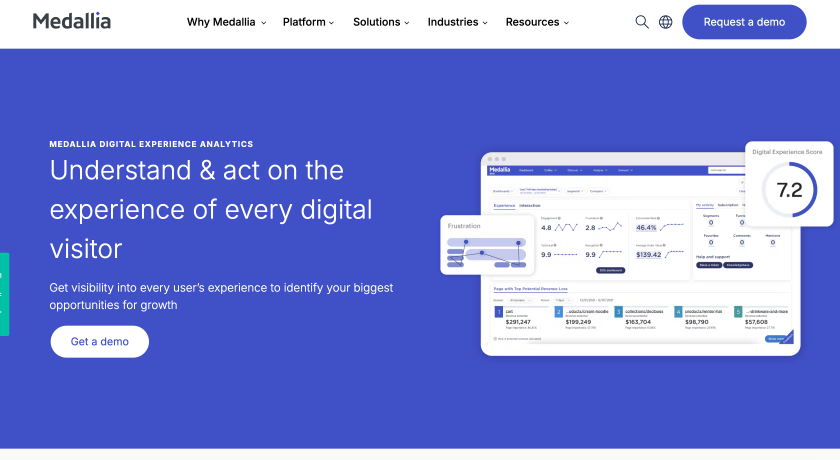
I’d consider Medallia the enterprise option for qualitative website analytics.
They’ve got all the features you’d expect: session replays, form analytics, heatmaps, and conversion funnels. These core features are also highly customizable with Medallia.
But they’ve also got some unique features, like the Digital Experience Score, a composite metric to score your website experience and identify core issues for optimization. This helps you identify and prioritize issues quickly, as well as see progress over time, which are two issues qualitative research tools tend to struggle with.
They’ve also got features to help you map out the customer journey as well as do smart segmentation. This gets you started on personalization as well as giving you deeper insights into different personas and user types that may be engaging with your website.
Price: Not available (request a demo)
G2 score: 4.4
Conclusion
Web analytics tools are a must in the modern era.
There are tons of options, ranging from the quantitative and behavioral (like Google Analytics, Snowplow and Adobe) to the product analytics category (like Mixpanel and Amplitude) to the qualitative (like HotJar, LuckyOrange, and Mouseflow). Some tools are even combining the qualitative and quantitative worlds to give you a more holistic view of the customer journey (such as Fullstory and Medallia).
There are also tools I left off of this list, like the whole class of SEO tools out there that help you monitor search performance, rankings, and backlinks (like Ahrefs or SEMRush).
There are also content specific tools like ChartBeat that give you detailed reports and real-time data user behavior specifically related to content, helping you to craft better marketing campaigns and marketing strategies. Alas, if I’d included them this list would be crazy long and barely useful.
At the end of the day, though, web analytics tools are necessary but not sufficient for progress. You’ll still need a team trained in data literacy and a data-driven culture to analyze your analytics data and actually take action on the insights you gain.
But this list should give you a solid start when it comes to considering which tools to implement to help you collect data on your website visitors.
